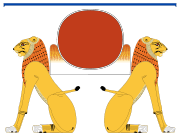Aker (deity)
| Aker in hieroglyphs | |||||||||
|---|---|---|---|---|---|---|---|---|---|
[1] | |||||||||
| |||||||||
| |||||||||
 Aker | |||||||||
Aker was an Ancient Egyptian earth and death deity.
Description
Aker was first depicted as the torso of a recumbent lion with a widely opened mouth. Later, he was depicted as two recumbent lion torsos merged with each other and still looking away from each other.[1]
From Middle Kingdom onwards Aker appears as a pair of twin lions, one named Duaj (meaning "yesterday") and the other Sefer (meaning "tomorrow"). Aker was thus often titled "He who's looking forward and behind". When depicted as a lion pair, a hieroglyphic sign for "horizon" (two merged mountains) and a sun disc was put between the lions; the lions were sitting back-on-back.[2]
In later times, Aker can also appear as two merged torsos of recumbent sphinxes with human heads.[3]
Cult
Aker appears first time during the 1st dynasty under the kings (pharaohs) Hor Aha and Djer.[1] An unfinished decorative palette from the tomb of Djer at Abydos shows Aker devouring three hearts.[4] The location of Aker's main cult center is unknown, though. His mythological role is first time fully described in the famous Pyramid Texts of king (pharaoh) Teti.[1]
Mythology
Aker was first described as one of the earth gods guarding the "gate to the yonder site". He protected the deceased king against the three demonic snakes Hemtet, Iqeru and Jagw. By "encircling" (i.e. interring) the deceased king, Aker sealed the deceased away from the poisonous breath of the snake demons. Another earth deity, who joined and promoted Aker's work, was Geb. Thus, Aker was connected with Geb. In other spells and prayers, Aker is connected with Seth and even determined with the Seth-animal. This is interesting, because Seth is described as a wind deity, not as an earth deity.[5][1]
In the famous Coffin Texts of Middle Kingdom period, Aker replaces the god Kherty, becoming now the "ferryman of Ra in his nocturnal bark". Aker protects the sun god during his nocturnal travelling through the underworld caverns.[1] In the famous Book of the Dead, Aker also "gives birth" to the god Khepri, the young, rising sun in shape of a scarab beetle, after Aker has carried Khepri's sarcophagus safely through the underworld caverns. In other underworld scenes, Aker carries the nocturnal bark of Ra. During his journey, in which Aker is asked to hide the body of the dead Osiris beneath his womb, Aker is protected by the god Geb.[3]
See also
References
- 1 2 3 4 5 6 Christian Leitz: Lexikon der ägyptischen Götter und Götterbezeichnungen (LGG) (= Orientalia Lovaniensia Analecta, vol. 6). Peeters Publishers, Leuven 2002, ISBN 9042911514, pp. 83 - 85.
- ↑ Pat Remler: Egyptian Mythology, A to Z. Infobase Publishing, 2010, ISBN 1438131801, pp. 4 & 5.
- 1 2 Friedrich Abitz: Pharao als Gott in den Unterweltsbüchern des Neuen Reiches (= Orbis biblicus et orientalis, vol. 146). Saint-Paul, 1995, ISBN 3525537816, pp. 119, 158 & 159.
- ↑ Peter Kaplony: Die Inschriften der ägyptischen Frühzeit, 3rd edition. Harrassowitz, Wiesbaden 1963, pp. 65.
- ↑ Georg Meurer: Die Feinde des Königs in den Pyramidentexten (= Orbis biblicus et orientalis, vol. 189). Saint-Paul, 2002, ISBN 3525530463, pp. 295, 296 & 311.